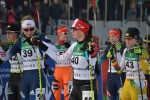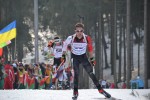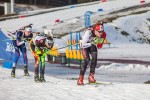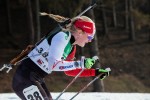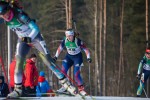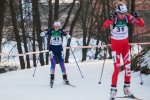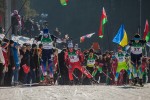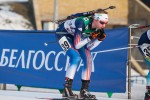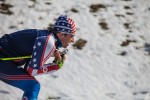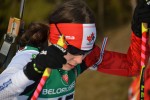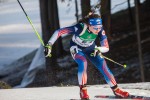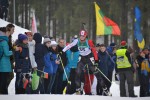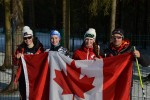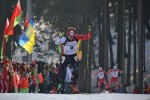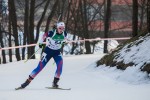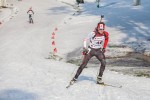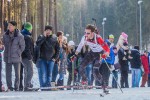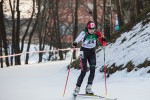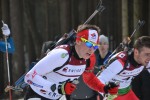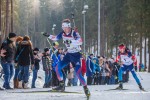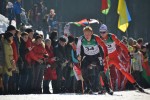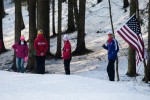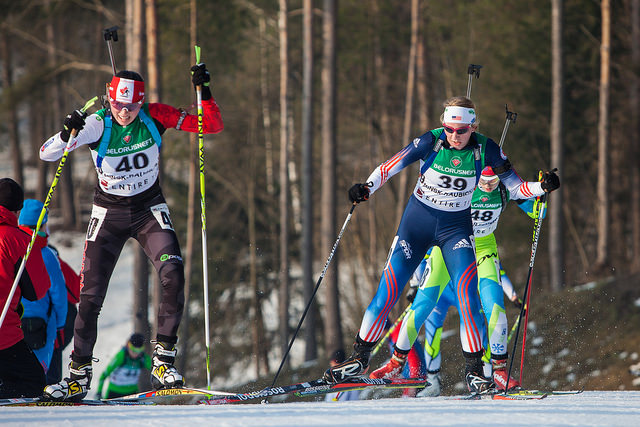
Sunday was a big day at the Raubichi biathlon venue outside of Minsk, Belarus. With four days of racing at IBU World Youth and Junior Championships, it was time for the pursuits: four on one day. Competitors completed four shooting stages, two prone and two standing, and skied 7.5 (youth women), 10 (junior women, youth men), or 12.5 kilometers (junior men).
With a pursuit format based on results from the previous days’ sprint competitions, there was plenty of excitement and finally, the first head-to-head racing of the Championships.
The youth women’s pursuit, Norway’s Ingrid Landmark Tandrevold cleaned both prone stages and by the second, had moved from third place up to first. She never relinquished her lead despite a penalty in each standing stage. Behind her was the drama: Darya Blashko, the Belorussian winner of the sprint, cross-fired onto Julia Schwaiger’s targets. The Austrian thus couldn’t shoot her own targets in a timely fashion, but was given a time credit that moved her into second place. Blashko was penalized ten minutes. Another Austrian, Simone Kupfner, finished third.
That may have been the most dramatic incidence in any of the races, but there was plenty of good, catastrophe-free racing. In the junior women’s pursuit, two women managed to shoot a perfect 20 for 20: Marie Heinrich of Germany, who moved from fourth after the sprint up through the leaders and won by 15.4 seconds over Galina Vishnevskaya of Russia, and Yuliya Zhuravok of Ukraine, who moved from eighth up to third. Maddie Phaneuf of the United States had three clean stages and one with two penalties, and moved from 33rd up to 22nd.
In the junior men’s competition, Eduard Latypov of Russia took the win by 24.4 seconds over Vermund Gurigard of Norway. Alexander Povarnitsyn, also of Russia, finished third. There were great hopes on North American competitors, but Sean Doherty and Aidan Millar both struggled on the range. Doherty had placed third in the sprint and Millar had placed eighth, but the pair finished 11th and 14th after seven and six penalties, respectively.
Finally, in the youth men’s pursuit, Felix Leitner of Austria won an exciting sprint finish against Kirill Streltsov of Russia. Streltsov had left the range for the final time 23 seconds behind Leitner, but made up 20 seconds on the trails and almost caught him by the finish. Mattias Haug of Norway finished third; all three hit 18 of their 20 shots. Pearce Hanna of Canada shot an impressive race, collecting only three penalties as he moved from 34th after the sprint all the way up to 13th place.
Here’s a photo gallery of the day; below the jump, find notes and quotes from the North American competitors.
The Top Finishers
“I am a little disappointed, definitely wanted to hit a few more targets but felt great on the skis again,” wrote Millar of his 14th-place finish. “The range was really calm so I’m not really sure why the shooting was so poor. Coming out of the range and up the first hill was very deep slush so I just tried to keep a half decent pace through there then make up ground on the firmer snow.”
“I was really happy with my shooting, I think that’s the best percentage (90% hits) I’ve had in a four stage shooting race before,” explained Phaneuf, who is in her first year of junior racing after competing as a youth last season. “Going into the pursuit I was mostly just getting really excited to race, because pursuits always seem to be more chaotic and fun. I told myself before the race that a lot of time can be made up on the range, and if I shot well I could move up quite a bit…which was true! It was nice to see myself getting a top 25, and only being 8 seconds out of the top 20.”
On Gaining Experience
Phaneuf has been bouncing all over Europe so far this season, competing at Open European Championships as well as on the World Cup, where she competed in a sprint and a relay.
“I think being over here in Europe for over a month before these World Junior races really helped me get ready,” she wrote. “This season I raced more international races than I ever have before, and now I see myself being much more comfortable in this type of higher competition… I think being slowly introduced to the highest level has helped me as an athlete. It also has given me an idea of what I need to do to stay on that level of competition. I know I am not ready to make the full jump into the World Cup level, but in the next couple of years I hope to see myself becoming competitive on that circuit.”
“I have definitely felt more prepared this time round, because I knew, more or less, what to expect,” wrote Canada’s Megan Bankes, who raced from 45th up to 27th in the youth women’s pursuit. “Last year was mainly about the experience, and this year I was more focused on results.”
“I am a first year junior this year, so I have one more year to prove myself at the World Champs, next year being in Romania,” wrote Canada’s Matt Strum, who placed 49th in the junior pursuit. “Compared to my trip in 2013 to Obertilliach, I feel like a stronger athlete, more capable, and generally more prepared for what was to come, as the Champs are probably the biggest events I have attended. In Austria, it was a bit of a shock to the system, and I was more in awe of my accomplishment of making the team, so my performance probably wasn’t at the peak for that season. This year however, I have more experience racing internationally, so I have expected to and succeeded at performing at a higher level.”
Or, On Being a Newbie
“This being my first international competition has been quite the eye opener,” wrote Canada’s Bryn Robertson, who finished 40th in both the sprint and the pursuit. “When you come here you realize how big the sport is in Belarus, and Europe for that fact. It is amazing to see hundreds of spectators at the range and lining the course during the races with flags waving and horns honking as the competitors ski by. Talking to some of the other competitors here is very inspiring because of how energized they are about the sport and how hard they work to improve themselves. This made me realize how important it is to have a dream and to set goals to get to that dream because otherwise you will never get where you want to be racing if the heart isn’t there. And in Europe, the heart is really there.”
“The level of competition is insane,” agreed fellow youth competitor Amanda Kautzer of the U.S. “I found myself saying over and over ‘wow, those (insert country name here) are so fast/strong/ good shooters.’ I am glad for the opportunity to be here as it is definitely making me a better athlete. I’m just trying to absorb and learn as much as I can from all the amazing athletes around me.”
On Shooting Well
“Today in the pursuit, I knew that my skiing would be pretty strong, so I really focused on making each shot count, and not going to the penalty loop,” wrote Canada’s Bankes. “After missing 2 in the first prone, I was a little disheartened, but got a correction, and then only had one other miss in my first standing. I was particularly happy with my second standing shooting because I cleaned, and had the 4th fastest shooting time for the bout.
“When I came into the second standing, I didn’t take time to really set my position and focus my attention on the targets before I started shooting and missed 3 which set me back a little,” wrote teammate Robertson. “The range was very busy! It is very different from racing in Canada because there are so many people rushing into the range at once. It can be very distracting! You don’t realize how ten other people entering the range at the same time as you can influence your mind space!”
“To be honest, I think I got a little too excited,” wrote Kautzer of a stage where she missed four shots. After placing 39th in the sprint, she finished 46th in the pursuit. “I zeroed for no wind, and there was a slight wind coming into the range the first stage so I took 2 clicks. At home I mostly shoot at a small 10 point range in the middle of the woods virtually wind free, so was very nervous about the wind and how to take clicks. By the time I got to standing I was relieved I didn’t have to worry about clicks and since the prone had gone so well (usually I miss more prone) I thought standing would go better. I rushed it and took shots that I should have waited out and taken another breath for.”
On Last-Lap Heroics
“The last lap was very hard but also a lot of fun,” wrote Canada’s Millar, who had to defend his 14th-place position from several challengers and held off Germany’s Johannes Werner Donhauser by just 0.4 seconds. “I had a good battle with one of Germans and tried to drop him on the last hill before you come down in to the finish. He was able to stay with me but the great skis we’ve had all week helped me get the few meters I needed.”
On Disappointment
“Overall I’m indifferent with my results,” wrote Mikaela Paluszek of the U.S., who finished 55th in the pursuit. “Of course I wanted to do better than the paper showed, but I’m still learning. Being able to go to Open European Champs I do believe helped me a little bit as well. Without Open European Champs, Junior Worlds would only have been my second set of biathlon races this year. Despite getting sick for the last race in Estonia it was great to get a few more competitions done before Belarus.”
”I believe that I was focusing too much on keeping up with the field and was not aware of the speed coming into the range,” wrote Chloe Levins, an American who finished 18th in the youth women’s sprint but slipped to 42nd in the pursuit with nine penalties. “I am happier with my ski speed and believe that I maintained a good present focus throughout the race. I stayed relaxed, despite many misses, and accepted the challenge to make up some time on the track. I am disappointed in the outcome, but there are many things to learn from this race that will be useful going into another head-to-head competition tomorrow. I will focus on being smooth on the range without hesitation.”
“I was very disappointed with my result in the sprint,” wrote Jakob Ellingson, an American who placed 65th in the junior men’s sprint and missed the cutoff for the pursuit by 17 seconds. “I am not a fast enough skier to get away with missing 5, and I knew that ahead of time. I did ski as fast I had hoped I was going to, and if (biathlon is full of these ifs) I had held it together prone I could have had a good result. I know that on a better day I should be able hit more than I did. I am pretty sad that I wont have another chance to do what I know I’m capable of doing in an individual race here.”
On Crazy Crowds
“The number of spectators and the atmosphere here is crazy!” wrote Ellingson. “It has really been building up since the first race, not so many were here for the individual, but still more than I’ve ever had cheering for me in any race. Quite a few more for the sprint, and then so far the biggest day was the pursuit. I’m not sure if people will still be here for the relays today and tomorrow. It isn’t the weekend here anymore…
“But yes, the spectators did cheer for Americans as well,” he continued. “There are so many people and its like a party for them on the side of the trail, every body is really excited and when they see somebody skiing up the trail they start making noise. Even if its not a racer, in between races yesterday there were a few officials skiing the course, i think to make sure everything was still good to go, and even they were cheered all the way up the hills!”
On Motivation
“My goal for this competition was to place top 30, but I am not unhappy with my results because, in making that goal, I did not put into account all of the unexpected obstacles and distractions that I have faced,” wrote first-time youth competitor Robertson of Canada. “There has been huge value in what I have learned this week, despite the fact that my performance was probably lower than my typical performance in Canadian races. I have learned so much about international racing that I would never have discovered if I hadn’t had this opportunity. I have been inspired by my team, the crowds, and my competitors – and this will motivate me to train to the top of my abilities in time to come. This trip has given me something to work toward outside our small pool of Canadian athletes.”
Results:
Chelsea Little
Chelsea Little is FasterSkier's Editor-At-Large. A former racer at Ford Sayre, Dartmouth College and the Craftsbury Green Racing Project, she is a PhD candidate in aquatic ecology in the @Altermatt_lab at Eawag, the Swiss Federal Institute of Aquatic Science and Technology in Zurich, Switzerland. You can follow her on twitter @ChelskiLittle.

